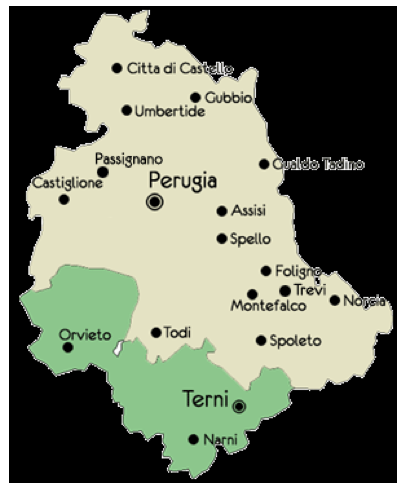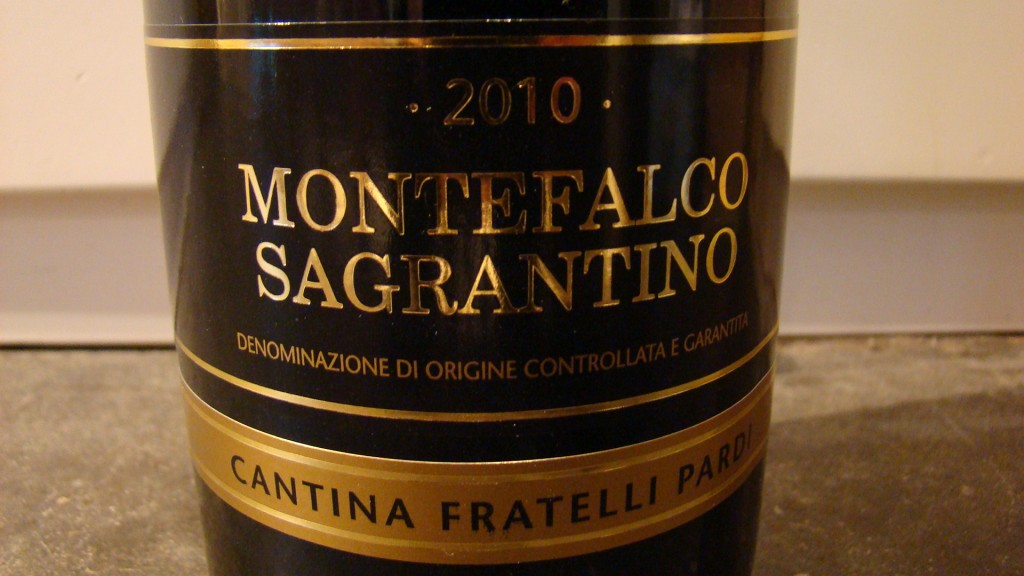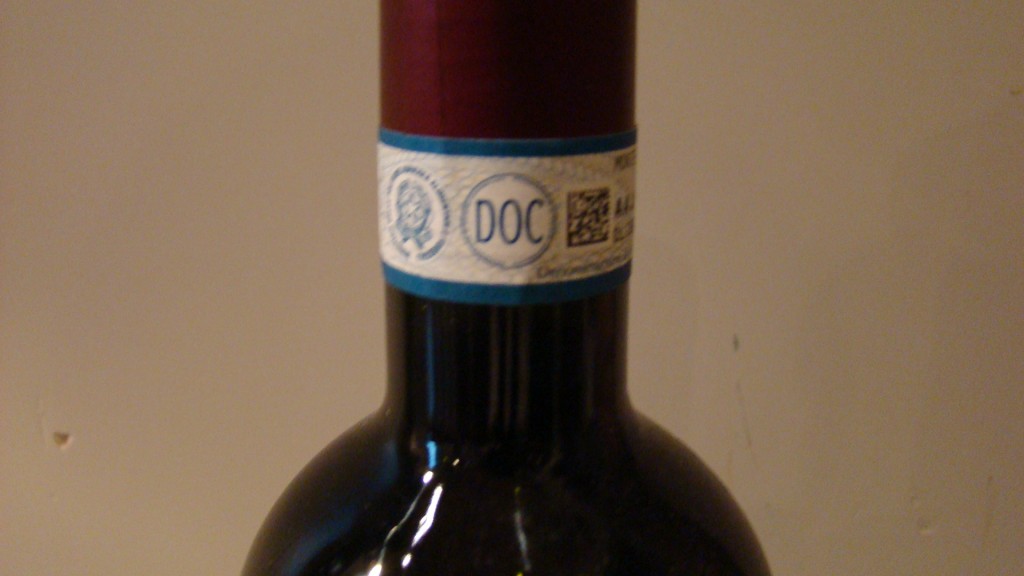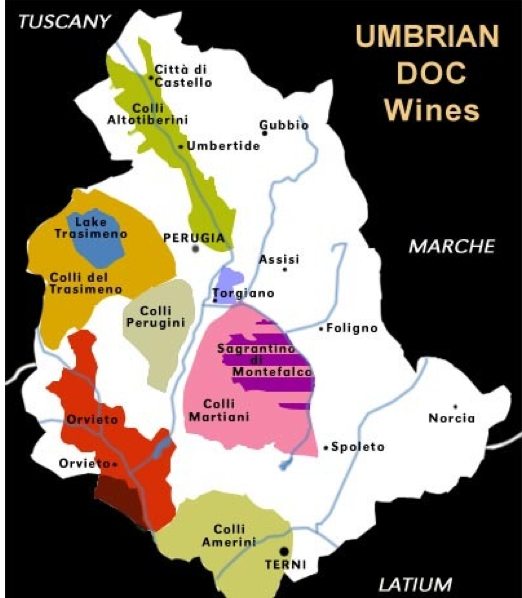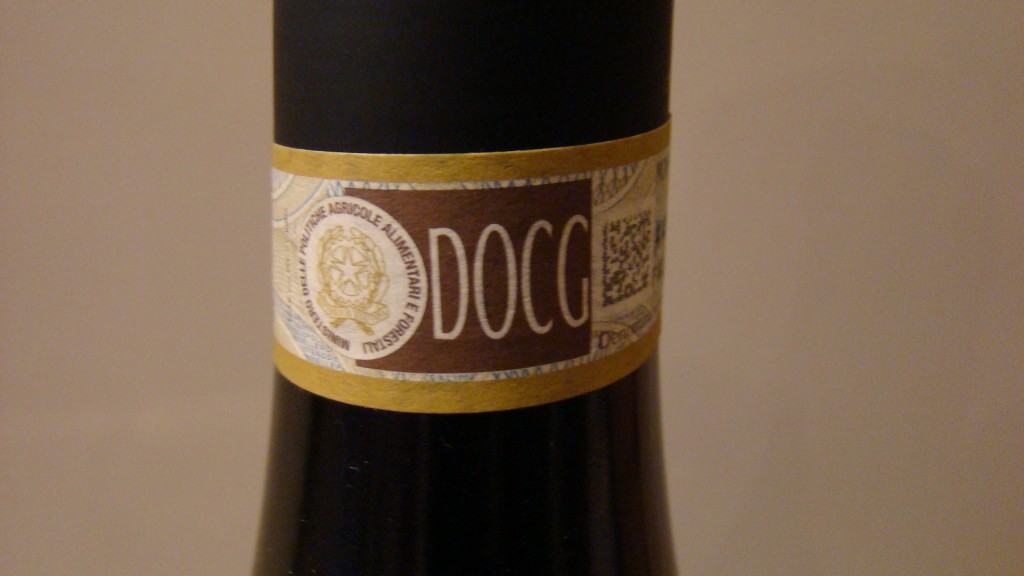People have been asking for a post about the wines around here. Luther has worked a WHOLE year on this and here is part one…
Wines of Umbria
Alright, already! I’ll write something now that I’ve had enough time to make a basic study.
Before we dive into the visits, here’s a bit of an introduction to Umbria and it’s wines. Geography lesson first.
Umbria
Here’s a map of Umbria. Like every other province in Italy, Umbria produces an ocean of wine, from the really good stuff to the ho-hum. Most of the really good stuff comes from a band stretching from Montefalco in the east to Orvieto in the west.
Montefalco and the area around it specializes in red wines, although plenty of white is made there too. The production slowly switches to white as you cross to Orvieto, although Orvieto also makes some very nice red wines. There’s a lot of wine made in Umbertide, our neck of the woods, but as you can see, we’re a bit north of the big leagues. For the curious, Tuscany with its Chiantis, Brunellos and Montepucianos lies just to the west of Umbria. To the east, you’ll find the Marche, which is known primarily for the white Verdicchio grape and the red wines from around Ascoli Piceno. If you’re wondering about the green part, Umbria has two provinces, Perugia and Terni. I’ll leave it to the reader to figure out which is which.
Umbrian Grapes
That’s enough geography for now, let’s talk grapes: There are four major grape types cultivated in Umbria: Sagrantino (red), Sangiovese (red), Grechetto (white) and Trebbiano (white). The DOC laws (more on this later) governing Italian wines require that these grapes form the majority of all red and white wines getting the DOC pedigree in Umbria. Lots of other grapes are allowed: in particular, merlot, cabernet sauvignon, chardonnay and sauvignon blanc. There are some adventurous winemakers, particularly in the southwest, who are making excellent wines based on Chardonnay, Cabernet and Merlot in particular and we will visit several, but let’s stick to the big boys for now.
Grechetto is the main white grape of Umbria and has been here since grapes and olives originally came to Umbria with the first Greek traders, who brought them from the colonies in the south of Italy in the 7th century BC. Grechetto has a deep straw color and has a minerality that I find particularly refreshing. It provides structure to any blend due to its relatively high alcohol content. Grechetto is the primary slamming down white of Umbria. You can get it out of wine shops by pump–yes, just like a gas pump–at about $1.50 a liter. When grechetto is made from older vineyards and the grapes are carefully selected, it makes excellent varietal wines, both alone or blended with other variatals. Grechetto ain’t Chambertin, but it can be quite tasty and is never particularily expensive. Very nice grechettos can be had here for about $5.00 a bottle.
Trebbiano is the other main wine grape of Umbria. It is fresh and fruity, with low acidity and a yellow color. Trebbiano goes back to Roman times and is one of the most widely planted grapes in the world, appearing in everything from balsamic vinegar (good!) to cognac (very good!) to industrial alcohol (unfortunate). Outside Italy, most trebbiano is undistingished and usually blended or distilled. In Italy, however, trebbiano can be a heavy hitter, appearing in Italy’s admittedly rather small list of really interesting white wines. Umbria boasts two excellent versions of trebbiano: Trebbiano spolentino, which (they tell me) is a unique form of the grape native to the area around Spello but present across southern Umbria and procanico, another unique (they tell me) Umbrian native version of trebbiano. These two, along with grechetto, form the basis for the wines known as Orvieto.
Wine Labeling
Years ago the Italians realized that if we foreigners keep associating Italian wines with the crap that appears in those straw covered bottles labelled “Chianti” they are never going to sell anything but their cheap sludge outside the country. To ensure that buyers didn’t feel like they needed to try the wine first on an unwanted family pet, the Italian government adopted a set of labelling standards known as the Denominazione di Origine Controllata (DOC). Each DOC governs a particular geographic region. In order to receive the DOC label for a region, the wine inside must adhere to government-defined quality standards for wines of region that specify: the origin of the grapes used (no sneaking stuff in from other places); the types of grapes that can be used (no slipping the cheap grapes in with the good stuff); the yields per acre (minimizing the juice from younger vines, which tend to yield higher, but poorer quality, wines than older vines); the percentages of allowed grape types in the wine, ensuring that blending wines stay blending wines, not the dominant grape in the bottle; and a whole bunch of other quality factors. DOC wines have the phrase Denominazione di Origine Controllata on the front and back labels and the name of the actual DOC. The presence of a DOC on a lable doesn’t guarantee a good wine, but it does indicate that the wine has been made from known components in a quality fashion. If you find yourself having to guess about a wine, you really can’t go wrong by opting for one with a DOC label on it.
So you know where they are, here’s a map of Umbria with its DOCs.
The DOC has been such a success in establishing Italy as a maker of quality wines commanding corresponding prices that the Italian government has upped the ante, introducing a much more exacting standard, the DOCG (Denominazione di Origine Controllata e Garantita). This term is for the wine regions or types considered particularily fine and adds further restrictions to the DOC standards. In addition to passing the more stringent standards, wines receiving the DOCG are rigorously tested during prooduction and submitted to a panel of tasters. There are a very limited number of DOCGs. Umbria, for example, has only three. As above, when faced with unknowns, go for the DOCG, if available. It will cost a bit more, but it figures to be extremely well made.
At this point you might be saying to yourself: Wow, I can become an afficionado just by knowing how to read the labels. Well, yes and no. The DOC/DOCGs are based on traditional Italian winemaking. For example, most traditionally great red wines from Tuscany are based primarily on the sangiovese grape, and to receive the DOC/DOCG, most DOC/DOCG red wines must be mostly, if not entirely, sangiovese based. In the last thirty years, winemakers have discovered that french grapes such as cabernet sauvignon and merlot also do very well in Tuscany and make tremendous wines, the so-called Supertuscans. Under the DOC/DOCG rules, these wines don’t qualify and in the past the winemakers were forced to lable these wines “Vino di Tavolo”, i.e., table wine. Not what you expect to see on the lable of a $100+ wine at all. To provide a little official cover for these winemakers, the label was borrowed from the food producers–it is used to indicate a local product of particular quality and shows up on things such as sunflower oil.
End of Guest Post
There will be a part 2. I hope it doesn’t take another year!

